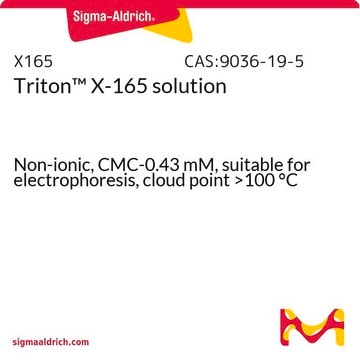X305
Triton™ X-305 solution
70% in H2O
Synonym(s):
Polyethylene glycol mono(4-tert-octylphenyl) ether, Polyethylene glycol p-octylphenol ether
Select a Size
Select a Size
About This Item
Recommended Products
description
non-ionic
Quality Level
mol wt
~1526.0 g/mol
concentration
70% in H2O
technique(s)
blocking: suitable
cell culture | mammalian: suitable
hybridization: suitable
immunohistochemistry: suitable
protein purification: suitable
CMC
0.65 mM
transition temp
cloud point >100 °C
HLB
17.3
SMILES string
O(CCO)c1ccc(cc1)C(CC(C)(C)C)(C)C
InChI
1S/C16H26O2/c1-15(2,3)12-16(4,5)13-6-8-14(9-7-13)18-11-10-17/h6-9,17H,10-12H2,1-5H3
Looking for similar products? Visit Product Comparison Guide
Related Categories
General description
Application
- In the treatment of cells for immunocytochemistry
- Along with peroxotungstic acid in the preparation of tungsten trioxide films by sol-gel method
- In the dispersion polymerization of styrene with activated poly(N-vinylpyrrolidone) (PVP) for the synthesis of lanthanide-encoded polystyrene particles
Legal Information
signalword
Danger
hcodes
Hazard Classifications
Acute Tox. 4 Oral - Aquatic Acute 1 - Aquatic Chronic 1 - Eye Dam. 1 - Skin Irrit. 2
Storage Class
10 - Combustible liquids
wgk_germany
WGK 2
flash_point_f
483.8 °F - closed cup
flash_point_c
251 °C - closed cup
ppe
Eyeshields, Faceshields, Gloves, type ABEK (EN14387) respirator filter
Choose from one of the most recent versions:
Certificates of Analysis (COA)
Don't see the Right Version?
If you require a particular version, you can look up a specific certificate by the Lot or Batch number.
Already Own This Product?
Find documentation for the products that you have recently purchased in the Document Library.
Customers Also Viewed
Our team of scientists has experience in all areas of research including Life Science, Material Science, Chemical Synthesis, Chromatography, Analytical and many others.
Contact Technical Service








